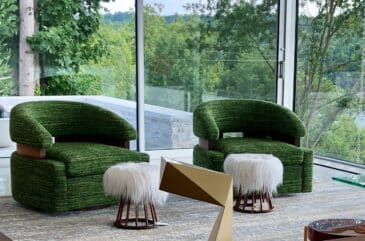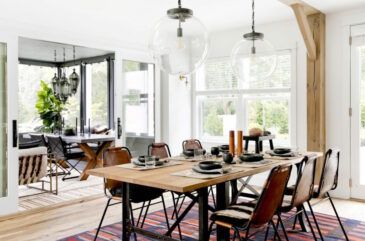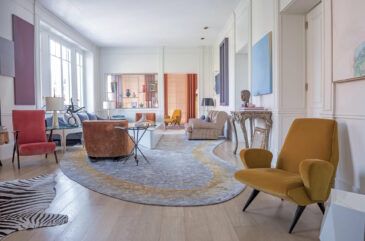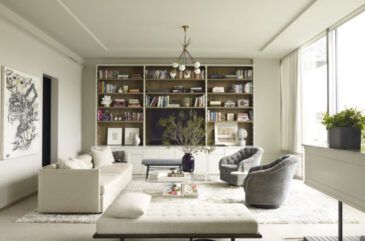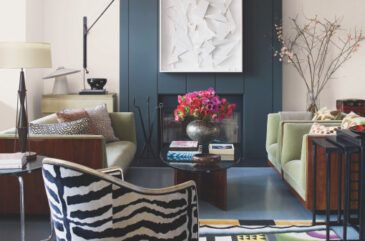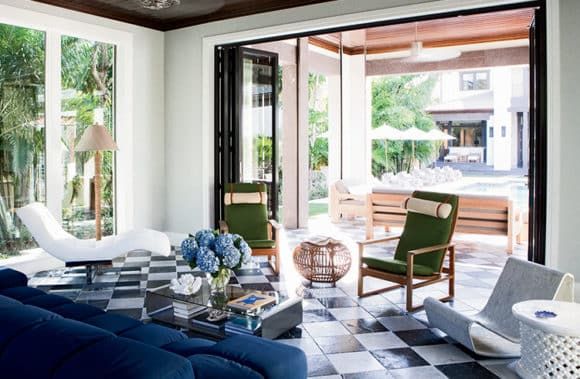
The first step to finding the perfect interior designer? Gather images of beautiful rooms, like this Florida home by Nate Berkus Associates.
The white paint two shades too yellow. The sofa that’s six inches too short. The lampshade that, somehow, should just be better. These simple and seemingly minor slip-ups can be enough to throw off the design of an entire room — and make a good case for outsourcing the design of one’s home to a professional interior decorator.
But the process of hiring an interior designer can be daunting, especially to the uninitiated. If you know you need a pro, but haven’t a clue how to find one or what happens after the ink is dry, read on. We tapped two of the industry’s leading ladies, Sasha Adler and Lauren Buxbaum Gordon, design directors of Nate Berkus Associates, to walk us through the process from research phase to move-in day.
Say you’ve never hired an interior designer before and don’t know where to start. What are some good ways to begin researching potential firms?
Lauren: I think some of the easiest ways to start are by asking friends whose style you admire and checking out your local design magazines. I think one of the best resources out there right now is Elle Decor’s A-List [Nate was named to the list in 2014]. I feel like they have one of the most well curated lists of interior designers all over the world, which we were very humbled to be a part of it this year. It will give you an idea of your core designers.
In this initial research phase, what criteria can you use to narrow down the hundreds of design firms out there to the three or four that you want to explore?
Sasha: Well I think it’s important to look at work that the designer has done before. I always tell our clients when they look at our portfolio that it may not be exactly how they want their home, but there should be something that resonates: they like the vibe of it, or they like the way things are put together, or the overall eye through which the designer presents everything.
Lauren: I also think there should be some semblance of love at first sight. That might be a bit dramatic, but at least a sense of “I wish I could live there, it feels like me.” And make sure you don’t let your city limit you. We work with clients all over the world. Don’t be afraid to call and ask potential designers if they are willing to work outside their city.
Sasha: Also, once you find someone whose aesthetic is a good fit for your own and feels right for your home, I think calling them and talking to them is really important. It’s sort of like dating in that you have to find someone that you click with because it’s an intimate process and you’ll be spending a lot of time together.
What happens next? Is there an “interview” process between clients and designers?
Lauren: For us, it’s less about an interview process and more about getting to know the client. We try to make it as informal and approachable as possible. We like to get to know them personally — how they like to live and what their style is, because that will greatly influence their home.
Sasha: I think when you find the right person you know. You can talk to one and if you hit if off, that could be it. But I always think it feels better to compare. If you talk to a few and they’re not right, then you really know the one you clicked with is the right one.

Adler and Gordon designed this Atlanta home for a family with seven kids. “The client was so fun — as nice as they come and a total free spirit,” says Lauren. “We wanted the décor to be a reflection of that.”
What can clients expect from this first meeting?
Sasha: When we initially speak to a client we try to get a feel for the scope of the project: if construction is involved, if selecting finishes is involved, if it’s just furniture. We also try to understand what their experience has been in the past, whether it’s been working with a designer or doing it themselves, as well as what types of homes they’ve lived in and their goals for their space. Aside from the aesthetics, we also try to get a feel for what they’re hoping for emotionally, and what sort of process they want; whether it’s something they want to be deeply involved in or something they’re just hoping to get done quickly.
What questions should a homeowner be asking their prospective designers at this point?
Lauren: I think you should really put them on the spot and say ‘What ideas do you have for my home? How can I live better and more comfortably? How do I make this home feel like a home my kids will want to return to?’ Obviously you should also ask for referrals and have them describe how their structure works and how the company is organized.
How important is it to know your budget at the outset of the project?
Lauren: I don’t think it’s that important. It’s more important to know what you’re looking for and how you want to live than to know your exact budget. Budgets can always be tailored.
What if you have no idea how to describe your style? Or no idea what your style is? How can you still manage to communicate to a designer what you’re looking for?
Sasha: Once we’ve decided to work together, we spend some time with whomever will be living in the home, whether it’s a couple, or a family with kids. We ask them to do a bit of homework to show us interiors and images they’re drawn to for whatever reason and pull them out from magazines or collect them on Pinterest so we get a sense of where their eye goes and what they gravitate towards. It could be anything from fashion to furniture to artwork, but it gives us a sense of overall aesthetic.
Lauren: It’s our job to really get to know the client and how they want to live in their space, so anything they can tell us about their style or what they’ve always dreamed of for their interior by showing us tears or pictures is helpful. We collect all of the evidence we can get our hands on and go from there.
Once you’ve decided to work together and determined a general style direction, where does the process go from there?
Sasha: We talk through the floorplan to make sure that it’s right for the client and that it flows correctly, then we move on to finishes. That’s our first meeting — we present the finishes that will really serve as the backdrop for the space. So that would be everything from flooring to tile, to stone selection, to bathroom finishes, things like that, if the home needs it.
From there we dive into specific rooms. At these meetings we present three-to-four rooms at a time, which includes a comprehensive picture of everything in the space. It’s actually a really fun process. We start with a floor plan and then we have options for each piece in the room. If I’m showing a living room I’ll have three sofas and three cocktail tables with every piece of information on the item. For instance: if it’s an antique or vintage item, where it’s from or when it’s from, exact dimensions, whether or not it needs reupholstery, pricing information, as well as multiple images of it.
It becomes almost like a game, because let’s say the client falls in love with one of the three sofas, and then maybe two of the three cocktail tables, and then we start to mix and match and piece things together. We discard whatever doesn’t work, and then by the end we have all of the furniture for the room. Then we go through the fabric and rugs and lighting so hopefully at the end of that meeting we have a great idea of the decor for the room.
How many meetings does it take to finish a project?
Sasha: It’s completely unique to the project because it depends on how large the home is.
How involved are clients usually in the design process of their homes?
Sasha: It really is a personal process and it’s quite intimate when you’re designing a home for their family and the way that they live. I’ve worked for Nate for almost 14 years, and a lot of the clients have become great friends of mine. I’ll meet up with them on vacation or I’ll keep in touch with them. In terms of their participation in the actual design, some clients are more into it than others and it becomes more of an interactive process. I love to show clients things that I’m interested in or that I’ve discovered, but sometimes it’s reciprocal. When clients come to me and say ‘Hey did you see this article or that new artist,’ it’s so exciting to me.

The team at Nate Berkus Associates transformed this Los Angeles bathroom: it was formerly filled with dark cabinetry and finished with an orange sponge paint.
What about existing pieces? Are designers usually OK with incorporating some of the furniture already in a client’s home?
Lauren: Unless the piece is awful, we embrace it because it helps a home feel more interesting and layered. It’s a bonus.
What are a few of the advantages to working with an interior designer that might not be so obvious to homeowners?
Lauren: For starters, [interior design] is way harder than it looks. Scale and proportion are very difficult to achieve without having the proper skills. Nate always likes to say your home should tell the story of who you are, and we really feel like that’s what we do well. We deliver the total package.
Sasha: We take all of the things that aren’t fun out of the design process so our clients can just focus on what they fall in love with. We’re doing all of the behind the scenes organizing and ordering and tracking, which isn’t always the smoothest process. But what we do for our clients that I think is the most amazing thing — and I don’t think I appreciated it as much until I moved myself — is that we handle the entire move-in. So we not only track everything and make sure it arrives on time and in great condition, but we ask our clients to turn the space over to us and we move everything in. We lay down the rugs, we place the furniture and we accessorize it down to the very smallest detail, putting their family photos in picture frames, hanging the art. By the time our clients walk into the space there is soap in the soap dish and towels on the towel racks, and the beds are made. When I was knee deep in my own move I was like ‘I want to hire our firm!’
Story by Kaitlin Madden. Madden is a Chicago-based writer and editor.
